Celebrating 5 years of the Very Large Telescope
March
31: One of the world's most advanced astronomical research facilities,
the ESO Very Large Telescope (VLT) at the Paranal Observatory in the Chilean Atacama
desert, has just celebrated an important anniversary.
 FULL
STORY FULL
STORY
 |  |

|
 |
Is Andromeda Galaxy a cannibal on our doorstep?
March
31: Astronomers have collected the first clear evidence that
the Andromeda Galaxy, also known as M31, is pulling one of its bright satellite
galaxies apart, and discovered 14 previously unknown globular clusters orbiting
far from the centre of M31 which could have been left behind when Andromeda devoured
their parent galaxies.
 FULL STORY FULL STORY
 |  |

|
 |
Ultraviolet astronomy in danger, scientists say
March
30: World astronomers are becoming very concerned about their ability to carry out observations in ultraviolet light following recent announcements about the future of the Hubble Space Telescope.
 FULL
STORY FULL
STORY
 |  |
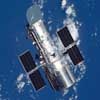
|
 |
Probe confirms methane in the Martian atmosphere
March
30: During recent observations from the European Space Agency's Mars Express spacecraft in orbit around Mars, methane was detected in its atmosphere. Whilst it is too early to draw any conclusions on its origin, exciting as they may be, scientists are thinking about the next steps to take in order to understand more.
 FULL STORY FULL STORY
 |  |

|
 |
Andromeda yields cache of stellar black holes
March
30: Astronomers have discovered ten previously unknown likely black holes in the Andromeda
Galaxy by means of a powerful new search technique they have devised. The Andromeda
Galaxy is the nearest neighbouring spiral galaxy, 2.5 million light years away.
 FULL
STORY FULL
STORY
 |  |

|
 |
Cassini examines high winds on Saturn
March
28: Wind-blown clouds and haze high in Saturn's atmosphere are
captured in a movie made from images taken by the Cassini narrow angle camera.
In the movie, atmospheric motions can be seen most clearly in the equatorial region
and at other southern latitudes.
 FULL STORY FULL STORY
 |  |

|
 |
Hubble's successor — U.K. takes a leading role
March
25: Formerly known as the Next Generation Space Telescope, the
James Webb Space Telescope is a joint project between NASA, the European Space
Agency and the Canadian Space Agency. Its journey begins a few years after the
Hubble Space Telescope's amazing two-decade exploration draws to a close.
 FULL
STORY FULL
STORY
 |  |

|
 |
White dwarf explodes inside circumstellar disc
March
24: By measuring polarized light from an unusual exploding star,
an international team of astrophysicists and astronomers has worked out the first
detailed picture of a Type Ia supernova and the distinctive star system in which
it exploded.
 FULL STORY FULL STORY
 |  |

|
 |
Galaxy debris the smoking gun for dark matter?
March
24: Weakly Interacting Massive Particles, or WIMPs, speeding
at 670,000 mph on a "highway" in space may be raining onto Earth — a phenomenon
that might prove the existence of "dark matter" that makes up most our galaxy
and one-fourth of the universe, says a study co-authored by a University of Utah
physicist.
 FULL STORY FULL STORY
 |  |

|
 |
Rover finds evidence of ancient sea on Mars
March
23: Three weeks ago, NASA announced definitive evidence that
Mars once featured an abundance of water supporting a habitable environment. But
major questions remained. Tuesday, scientists unveiled photographs from NASA's
Opportunity rover showing cross-bedded sedimentary rocks indicating that at least
at one point on the martian surface — Meridiani Planum — a shallow,
salty sea once ebbed and flowed.
 FULL STORY FULL STORY
 MISSION STATUS CENTER MISSION STATUS CENTER
 |  |

|
 |
A new star is born
March
23: A timely discovery by American amateur astronomer Jay McNeil,
followed immediately by observations at the Gemini Observatory, has provided a
rare glimpse into the slow, yet violent birth of a star about 1,500 light-years
away. The resulting findings reveal some of the strongest stellar winds ever detected
around an embryonic Sun-like star.
 FULL STORY FULL STORY
 |  |

|
 |
New imagery of comet released from Stardust
March 19:
NASA's Stardust spacecraft successfully survived flying through the dust and gas cloud surrounding comet Wild 2 in January. During the flyby, the highest resolution images ever taken of a comet's nucleus were obtained and have been the subject of intense study since the flyby.
 FULL STORY FULL STORY
 |  |

|
 |
Asteroid's close brush with Earth
March 18:
Discovered by astronomers of MIT's Near-Earth Asteroid Research (LINEAR) survey
just two days previously, house-sized 2004 FH made the closest flyby of Earth
ever predicted on the night of March 18th.
 FULL
STORY FULL
STORY
 |  |

|
 |
Students control their own research-class telescopes
March 16:
Children throughout the U.K. will be among the first to see amazing astronomical
images from the comfort of their classrooms by controlling two professional 2-metre
telescopes in Hawaii and Australia via the Internet.
 FULL
STORY FULL
STORY
 |  |

|
 |
Most distant solar-system object discovered
March 15:
Detected at Mount Palomar Observatory in California, the new world may be called
Sedna after the Inuit goddess of the sea. Believed to have a diameter of about
1000 miles, it currently lies three times further away than Pluto with an orbital
period of approximately 10,500 years. Its orbit is very elongated, averaging 480
astronomical units (a.u.) from the Sun.
 FULL
STORY FULL
STORY
 |  |

|
 |
Six-terabyte sky catalogue released to public
March 15:
One of the largest astronomy catalogues ever compiled was released to the public Monday
by the Sloan Digital Sky Survey. With photometric and spectroscopic observations
of the sky gathered during the last two years, this second data release offers
six terabytes of images and catalogues, including two terabytes in an easy to
use searchable database.
 FULL STORY FULL STORY
 |  |

|
 |
Clumps in Saturn's rings
March 12:
Scientists have only a rough idea of the lifetime of clumps in Saturn's rings
— a mystery that Cassini may help answer. The latest images taken by the
Cassini-Huygens spacecraft show clumps seemingly embedded within Saturn's narrow,
outermost F ring.
 FULL
STORY FULL
STORY
 |  |

|
 |
Two asteroid fly-bys for comet probe Rosetta
March 11:
The Rosetta Science Working Team has made the final selection of two asteroids,
named Lutetia and Steins, that Rosetta will observe at close quarters during its
journey to Comet 67P/Churyumov-Gerasimenko.
 FULL
STORY FULL
STORY
 |  |
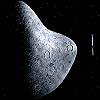
|
 |
Hubble's deepest view ever unveils earliest galaxies
March 9:
Astronomers at the Space Telescope Science Institute today unveiled the deepest
portrait of the visible universe ever achieved by humankind. Called the Hubble
Ultra Deep Field (HUDF), the million-second-long exposure reveals the first galaxies
to emerge from the so-called "dark ages," the time shortly after the big bang
when the first stars reheated the cold, dark universe.
 FULL
STORY FULL
STORY
 |  |
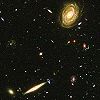
|
 |
25-metre telescope planned for Chile
March 9:
The California Institute of Technology and Cornell University are in the planning
stages for a new 25-metre telescope to be built in Chile. The submillimetre telescope
will cost an estimated $60 million and will be nearly two times larger in diameter
than the largest submillimetre telescope currently in existence.
 FULL
STORY FULL
STORY
 |  |

|
 |
Rovers watch solar transits by Martian moons
March 8:
NASA's Mars Exploration Rovers have become 'eclipse' watchers. Opportunity is the first
space probe to see moons pass in front of the sun from the surface of another world.
 FULL
STORY FULL
STORY
 |  |

|
 |
X-ray emissions detected from Saturn
March 8:
For the first time, an unambiguous X-ray emission has been detected on Saturn
by a team from Hamburg University (Germany). The image obtained with the Chandra
X-ray Observatory clearly shows an emission concentrated near Saturn's equator,
though the underlying physical processes remain unknown.
 FULL STORY
FULL STORY
 |
 |
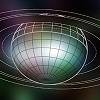
|
 |
V838 Monocerotis: light echo imitates art
March 4:
"Starry Night", Vincent van Gogh's famous painting, is renowned
for its bold whorls of light sweeping across a raging night sky.
This new picture from the NASA/ESA Hubble Space Telescope bears
remarkable similarities to the van Gogh work, complete with never-before-seen
spirals of dust swirling across trillions of kilometres of interstellar
space.
 FULL STORY
FULL STORY
 |
 |
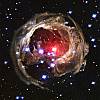
|
 |
Rosetta's comet target seen from Earth telescope
March 3:
The European Space Agency's Rosetta spacecraft was launched this
week to rendezvous with Comet 67P/Churyumov-Gerasimenko. Astronomers
using the New Technology Telescope at the European Southern Observatory
of La Silla in Chile have imaged the "dirty snowball" comet.
 FULL STORY
FULL STORY
 |
 |

|
 |
Rover confirms past liquid water on Mars
March 2:
NASA's Opportunity rover, studying exposed bedrock in the crater where it landed by chance in January, has found clear evidence that Mars once supported a wet, habitable environment, one that would have been suitable for life, scientists announced Tuesday.
 FULL
STORY FULL
STORY
 MISSION
STATUS CENTER - updates MISSION
STATUS CENTER - updates
 EARLIER
STORY EARLIER
STORY
 ROVER
NEWS ARCHIVE ROVER
NEWS ARCHIVE
 |  |

|
 |
VLT finds most distant known galaxy
March 1:
Using the ISAAC near-infrared instrument on ESO's Very Large
Telescope, and the magnification effect of a gravitational
lens, a team of French and Swiss astronomers has found several
faint galaxies believed to be the most remote known.
 FULL STORY FULL STORY
 |
 |

|
 |
Enigmatic X-rays may point to new class of black holes
March 1:
Mysterious, powerful X-ray sources found in nearby galaxies may
represent a new class of objects, according to data from NASA's
Chandra X-ray Observatory. These sources, which are not as hot as
typical neutron-star or black-hole X-ray sources, could be a large
new population of black holes with masses several hundred times
that of the sun.
 FULL
STORY FULL
STORY
 |
 |

|
 |



